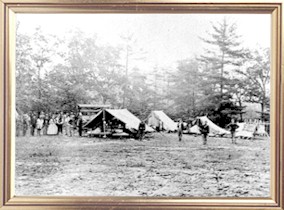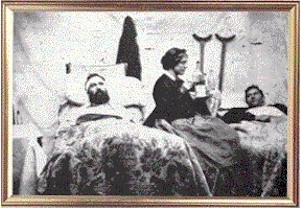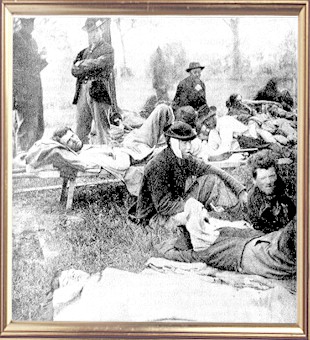
|
Battlefield
Hospitals
|

|
|
|
Women played an important role in the Civil War. They had to help
all of the wounded soldiers and that's how battlefield hospitals were developed.
At first mothers and daughters took wounded soldiers into their homes and
cared for them. Then there came battlefield hospitals. Two
thousand women served as volunteer nurses in military hospitals during
the war. These women often had notable impact on the men they tended.
Dorthea Dix and Clara Barton were the leaders to organize a nursing corps
to care for the warís wounded and sick. |

|
They were only allowed two small tents for the officers and medicines,
another small tent for the kitchen department and supplies, and one large
tent for the sick. This tent was about fourteen feet square and could
contain eight cots with room for eight patients.
At the beginning of the Civil War the U.S. Surgeon General's office included
a total of one hundred fifteen surgeons. Hospitals didn't have very
much of what they needed, but they did the best they could with what they
had. |
|
|
The stock of medicines was limited to certain standards. Almost all
of the medicines were administered in powder or in a liquid state.
Tablets hadn't came into use yet and pills weren't used either. The
result was that most powders were stirred in water and swallowed. |
|
Most of the wounds healed in the end. The largest proportion of wounds
was made with bullets called minie balls. When a minie ball struck
a bone it always fractured or shattered a bony structure. |
|
It is surprising to believe that most of the deaths came from disease and
illness rather than from bullets. Even more soldiers died from diarrhea
than bullet wounds. The statistics for the Union armies consisted
of sixty-seven thousand killed in action, forty-three thousand died of
wounds, and two hundred twenty four thousand died of disease. Also
an additional twenty-four thousand are listed as dead from other causes.
Confederate armiesí statistics are comparable to the Union's. The
average age group of the soldiers was eighteen. |
|
Seventy-five of all the operations were amputations. Surgery hadn't
moved to an understanding of antiseptic conditions yet. A doctor
would use the same knife all day, wiping his hands and tools on his apron
when they became too slimy to work with. An experienced surgeon could
amputate a limb within minutes, but some volunteer surgeons at Gettysburg
didn't do anything for a week except cut off arms and legs from dawn until
twilight. |
|

|
| |
Union and
Confederate Amputation Cases
|
Cases |
Deaths |
| Fingers |
7,902 |
198 |
| Arms |
7,301 |
1,518 |
| Toes |
1,519 |
81 |
| Shins |
5,523 |
1,790 |
| Thighs |
6,369 |
3,411 |
| Knee Joints |
195 |
111 |
| Hip Joints |
66 |
55 |
| Ankle Joints |
161 |
119 |
|
|

|
|
|
The soldiers lived in unhealthy conditions. They were often poorly
fed and crowded together. Alcohol, which was usually in the forms
of whiskey and brandy, was the most commonly prescribed medication for
the North and South. |
|
Living was very hard for the soldiers, surgeons, nurses, volunteers, of
the battlefield hospitals, and for many families. I am surprised
that as many people lived as they did with all the bad conditions.
|




